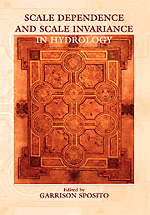Book contents
- Frontmatter
- Contents
- List of Contributors
- Preface
- 1 Scale Analyses for Land-Surface Hydrology
- 2 Hillslopes, Channels, and Landscape Scale
- 3 Scaling in River Networks
- 4 Spatial Variability and Scale Invariance in Hydrologic Regionalization
- 5 An Emerging Technology for Scaling Field Soil-Water Behavior
- 6 Scaling Invariance and the Richards Equation
- 7 Scaling of the Richards Equation and Its Application to Watershed Modeling
- 8 Scale Issues of Heterogeneity in Vadose-Zone Hydrology
- 9 Stochastic Modeling of Scale-dependent Macrodispersion in the Vadose Zone
- 10 Dilution of Nonreactive Solutes in Heterogeneous Porous Media
- 11 Analysis of Scale Effects in Large-Scale Solute-Transport Models
- 12 Scale Effects in Fluid Flow through Fractured Geologic Media
- 13 Correlation, Flow, and Transport in Multiscale Permeability Fields
- 14 Conditional Simulation of Geologic Media with Evolving Scales of Heterogeneity
- Index
11 - Analysis of Scale Effects in Large-Scale Solute-Transport Models
Published online by Cambridge University Press: 18 January 2010
- Frontmatter
- Contents
- List of Contributors
- Preface
- 1 Scale Analyses for Land-Surface Hydrology
- 2 Hillslopes, Channels, and Landscape Scale
- 3 Scaling in River Networks
- 4 Spatial Variability and Scale Invariance in Hydrologic Regionalization
- 5 An Emerging Technology for Scaling Field Soil-Water Behavior
- 6 Scaling Invariance and the Richards Equation
- 7 Scaling of the Richards Equation and Its Application to Watershed Modeling
- 8 Scale Issues of Heterogeneity in Vadose-Zone Hydrology
- 9 Stochastic Modeling of Scale-dependent Macrodispersion in the Vadose Zone
- 10 Dilution of Nonreactive Solutes in Heterogeneous Porous Media
- 11 Analysis of Scale Effects in Large-Scale Solute-Transport Models
- 12 Scale Effects in Fluid Flow through Fractured Geologic Media
- 13 Correlation, Flow, and Transport in Multiscale Permeability Fields
- 14 Conditional Simulation of Geologic Media with Evolving Scales of Heterogeneity
- Index
Summary
Introduction
This chapter presents a framework in which to understand the scale dependence and interaction of scales in large-scale models of conservative solute transport in groundwater. We are interested in models of conservative solute transport at practical field scales, on the order of a few meters to many kilometers. In particular, we examine how the dynamics on different scales are represented and interact in models developed using large-eddy-simulation (LES) methods from geophysical fluid dynamics (Rogallo and Moin, 1984). LES methods provide an ideal framework for our analysis because they allow us to define the scale of our model precisely.
This chapter presents a synthesis of findings from both groundwater hydrology and computational fluid dynamics. Our principal contribution will be to bring these two fields together in applications to groundwater problems. We shall first review the conceptual and technical basis for application of LES methods to conservative solute transport. We shall then examine the effects of advection and dispersion on the variability in the concentration field. We shall next investigate the effects of smaller-scale advection on the larger-scale component of the concentration field. We shall conclude with a brief and speculative analysis of strategies to incorporate the effects of unresolved, smaller-scale processes in larger-scale models of solute transport in groundwater.
Overview of LES
The roots of LES are in geophysical and engineering computational fluid dynamics, where many problems of interest involve turbulence (Rogallo and Moin, 1984). Turbulent velocity fields, governed by the Navier-Stokes equations, vary over a wide and continuous range of length and time scales.
Information
- Type
- Chapter
- Information
- Scale Dependence and Scale Invariance in Hydrology , pp. 314 - 334Publisher: Cambridge University PressPrint publication year: 1998
Accessibility standard: Unknown
- 10
- Cited by
